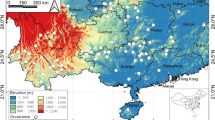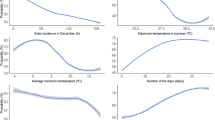Abstract
The objective of this study was to identify climatic factors determining the distribution of a keystone understory taxon, section Crassinodi of the genus Sasa, and assess the impacts of climate change on the taxon. Relationships between the distribution of sect. Crassinodi and five climatic variables were explored using classification tree analysis. Potential habitats under current climate and future climate in 2081–2100 were predicted. Potential habitats were further divided into suitable and marginal habitats. The predictive accuracy of the model was assessed using receiver operating characteristic analysis and by comparing model predictions with an independent dataset. The model was reasonably accurate. It showed that the warmth index (WI) and snow cover were the most important climatic variables for Crassinodi distribution. Potential habitats were limited to cooler regions with WI <102.7°C month. Suitable habitats were limited to even cooler regions with WI <84.8°C month. The model also showed that areas with deeper snow than previously reported would provide suitable habitats for Crassinodi under some climatic conditions. In 2081–2100, 37.4% of current potential habitats are predicted to become non-habitats because of increases in WI. Most currently suitable habitats are predicted to vanish from western Japan by 2081–2100. Meanwhile, Hokkaido and high-elevation areas of eastern Honshu will sustain suitable habitats. Sect. Crassinodi, which is adapted to less snowy climates, is predicted to be more affected by climate change than sect. Sasa and Macrochlamys, which are adapted to snowy climates.






Similar content being viewed by others
Abbreviations
- WI:
-
Warmth index
- TMC:
-
Mean of the daily minimum temperature of the coldest month
- PRS:
-
Summer precipitation
- MSW:
-
Maximum snow water equivalent
- WR:
-
Winter rainfall
- SDD:
-
Suzuki’s distribution data
- PRDB:
-
Phytosociological Relevé Data Base
- DWS:
-
Deviance-weighted score
References
Agata W, Kamata E (1979) Ecological characteristics and dry matter production of some native grasses in Japan. J Jpn Soc Grassl Sci 25:103–109 (in Japanese with English summary)
Armonies W, Reise K (2003) Empty habitat in coastal sediments for populations of macrozoobenthos. Helgoland Mar Res 56:279–287
Begon M, Harper J, Townsend C (1996) Ecology: individuals, populations and communities, 3rd edn. Blackwell, Oxford
Braun-Blanquet J (1964) Pflanzensoziologie, 3 Aufl. Springer, Wien
Clark L, Pregibon D (1992) Tree-based models. In: Chambers J, Hastie T (eds) Statistical models in S. Wadsworth & Brooks/Cole Advanced Books & Software, California, pp 377–419
Colwell R, Brehm G, Cardelus C, Gilman A, Longino J (2008) Global warming, elevational range shifts, and lowland biotic attrition in the wet tropics. Science 322:258–261
De’ath G, Fabricius K (2000) Classification and regression trees: a powerful yet simple technique for ecological data analysis. Ecology 81:3178–3192
Efron B (1979) Bootstrap methods: another look at the jackknife. Ann Stat 7:1–25
Furusawa H, Miyanishi H, Kaneko S, Hino T (2003) Movement of soil and litter on the floor of a temperate mixed forest with an impoverished understory grazed by Deer (Cervus nippon centralis Temminck). J Jpn For Soc 85:318–325 (in Japanese with English summary)
Garzón MB, de Dios RS, Ollero HS (2008) Effects of climate change on the distribution of the Iberian tree species. Appl Veg Sci 11:169–178
Hannah L, Midgley G, Millar D (2002) Climate change-integrated conservation strategies. Glob Ecol Biogeogr 11:485–495
Hino T (2000) Bird community and vegetation structure in a forest with a high density of sika deer. Jpn J Ornithol 48:197–204
Horikawa M, Tsuyama I, Matsui T, Kominami Y, Tanaka N (2009) Assessing the potential impacts of climate change on the alpine habitat suitability of Japanese stone pine (Pinus pumila). Landsc Ecol 24:115–128
Inoue S, Yokozawa K (2003) Estimates of snowfall depth, maximum snow depth, and snow pack environments under global warming in Japan from five sets of predicted data. J Agric Meteorol 59:227–236
IPCC (2001) Climate change 2001: impacts, adaptation and vulnerability. Contribution of working group II to the third assessment report of the intergovernmental panel on climate change. Cambridge University Press, Cambridge
IPCC (2007a) Climate change 2007: the physical science basis. Contribution of working group I to the fourth assessment report of the intergovernmental panel on climate change. Cambridge University Press, Cambridge
IPCC (2007b) Climate change 2007: impacts, adaptation and vulnerability. Contribution of working group II to the fourth assessment report of the intergovernmental panel on climate change. Cambridge University Press, Cambridge
Iverson L, Prasad A (1998) Predicting abundance of 80 tree species following climate change in the eastern United States. Ecol Monogr 68:465–485
Iwate Syokubutsu no Kai (1970) Flora of Iwate. Iwate Syokubutsu no Kai, Morioka (in Japanese)
Japan Map Center (1998) Numerical map user guide, 2nd version. Japan Map Center, Tokyo (in Japanese)
Japan Meteorological Agency (1960) A method of estimating monthly mean temperature. Tech Rep Jpn Meteorol Agency 2:1–33 (in Japanese)
Japan Meteorological Agency (1996) Climatic normals for Japan. Japan Meteorological Business Support Center, Tokyo (in Japanese)
Japan Meteorological Agency (2004) MRI-RCM20. Global Environment and Marine Department of Japan Meteorological Agency, Tokyo (in Japanese)
Karizumi N (1987) Structure of the underground part of Sasa species and soil-straining powers. Bamboo J 4:167–174 (in Japanese with English summary)
Kira T (1948) On the altitudinal arrangement of climatic zones in Japan. Kanti-Nougaku 2:143–173 (in Japanese)
Kominami Y, Tanaka N, Endo Y, Niwano S (2005) Estimation of snow distribution under global warming using data from remote weather stations (AMeDAS). J Agric Meteorol 60:445–450
Lenoir J, Gegout J, Marquet P, de Ruffray P, Brisse H (2008) A significant upward shift in plant species optimum elevation during the 20th century. Science 320:1768–1771
MathSoft Inc (2000) S-PLUS 2000 user’s guide. MathSoft Inc, Washington
Matsui T, Yagihashi T, Nakaya T, Tanaka N, Taoda H (2004a) Climatic controls on distribution of Fagus crenata forests in Japan. J Veg Sci 15:57–66
Matsui T, Yagihashi T, Nakaya T, Taoda H, Yoshinaga S, Daimaru H, Tanaka N (2004b) Probability distributions, vulnerability and sensitivity in Fagus crenata forests following predicted climate changes in Japan. J Veg Sci 15:605–614
Matsui T, Tanaka N, Yagihashi T (2007) Predicting changes in suitable habitats for beech (Fagus crenata Blume) forests under climate warming in Shirakami Mountains World Natural Heritage Area, Northern Japan. J Jpn For Soc 89:7–13 (in Japanese with English summary)
Metz C (1978) Basic principles of ROC analysis. Semin Nucl Med 8:283–298
Miyabuchi Y, Sugiyama S (2008) A 30,000-year phytolith record of a tephra sequence at the southwestern foot of Aso Volcano, Japan. J Geogr 117:704–717 (in Japanese with English summary)
Nakao K, Matsui T, Horikawa M, Tsuyama I, Tanaka N (2010) Assessing the impact of land use and climate change on the evergreen broad-leaved species of Quercus acuta in Japan. Plant Ecol 212:229–243
Nakashizuka T (1987) Regeneration dynamics of beech forests in Japan. Vegetatio 69:169–175
Ohsawa M (1993) Latitudinal pattern of mountain vegetation zonation in southern and eastern Asia. J Veg Sci 4:13–18
Opdam P, Wascher D (2004) Climate change meets habitat fragmentation: linking landscape and biogeographical scale levels in research and conservation. Biol Conserv 117:285–297
Pearson RG, Dawson TP, Liu C (2004) Modelling species distributions in Britain: a hierarchical integration of climate and land-cover data. Ecography 27:285–298
Sase T, Machida H, Hosono M (2008) Fluctuations of opal phytolith assemblage in the Tachikawa and Musashino loam formations in southwest Kanto, central Japan: changes in vegetation, climate, terrace, and soil-facies since marine isotope stage 5.1. Quat Res 47:1–14 (in Japanese with English summary)
Suzuki S (1961) Ecology of the Bambusaceous genera Sasa and Sasamorpha in the Kanto and Tohoku districts of Japan, with special reference to their geographical distribution. Ecol Rev 15:131–147
Suzuki S (1978) Index to Japanese Bambusaceae. Gakken, Tokyo (in Japanese)
Swets J (1988) Measuring the accuracy of diagnostic systems. Science 240:1285–1293
Takahashi K, Uemura S, Suzuki J, Hara T (2003) Effects of understory dwarf bamboo on soil water and the growth of overstory trees in a dense secondary Betula ermanii forest, northern Japan. Ecol Res 18:767–774
Takatsuki S (1986) Food habits of sika deer on Mt. Goyo, northern Honshu. Ecol Res 1:119–128
Tanaka N (2007) PRDB (Phytosociological Relevé Data Base). http://www.ffpri.affrc.go.jp/labs/prdb/index.html
Tanaka N, Matsui T, Shimada K, Yagihashi T, Taoda H (2005) Constructing vegetation database useful for assessing impact of climate changes in Japan. J Agric Meteorol 60:433–438
Taylor A, Zisheng Q (1987) Culm dynamics and dry matter production of bamboos in the Wolong and Tangjiahe Giant Panda Reserves, Sichuan, China. J Appl Ecol 24:419–433
Thuiller W, Lavorel S, Araújo M, Sykes M, Prentice I (2005) Climate change threats to plant diversity in Europe. Proc Natl Acad Sci USA 102:8245–8250
Toyooka H, Sato A, Ishizuka M (1981) The distribution and situation of dwarf-bamboo species in Hokkaido. Hoppo-Ringyo 33:143–146 (in Japanese)
Tsuyama I, Matsui T, Horikawa M, Kominami Y, Tanaka N (2008a) Habitat prediction and impact assessment of climate change on dwarf bamboo of the section Sasa in Japan. Theory Appl GIS 16:99–113 (in Japanese with English summary)
Tsuyama I, Matsui T, Ogawa M, Kominami Y, Tanaka N (2008b) Habitat prediction and impact assessment of climate change on Sasa kurilensis in eastern Honshu, Japan. Theory Appl GIS 16:11–25 (in Japanese with English summary)
Usui H (1961) Phytosociological revision of the dominant species of Sasa-type undergrowth—silvicultural application of the researches on Japanese forest vegetation. Spec Bull Coll Agric Utsunomiya Univ 11:1–35 (in Japanese with English summary)
Veblen T (1982) Growth patterns of Chusquea bamboos in the understory of Chilean Nothofagus forests and their influences in forest dynamics. Bull Torrey Bot Club 109:474–487
Wada N (1993) Dwarf bamboos affect the regeneration of zoochorous trees by providing habitats to acorn- feeding rodents. Oecologia 94:403–407
Woodall C, Oswalt C, Westfall J, Perry C, Nelson M, Finley A (2009) An indicator of tree migration in forests of the eastern United States. For Ecol Manag 257:1434–1444
Yasuda Y (1980) An introduction to environmental archaeology. Japan Broadcast Publishing Co. Ltd, Tokyo (in Japanese)
Yokozawa M, Goto S, Hayashi Y, Seino H (2003) Mesh climate change data for evaluating climate change impacts in Japan under gradually increasing atmospheric CO2 concentration. J Agric Meteorol 59:117–130
Acknowledgments
We thank Dr Akira Kato and Dr Erin Conlisk for their useful comments and language help on the manuscript. We also thank two anonymous reviewers, Dr Toshichika Iizumi, Dr Mifuyu Ogawa, Ms Yuko Ogawa, Mr Hiromu Daimaru, Dr Masatsugu Yasuda, and Ms Etsuko Nakazono for their valuable comments on the study. This study was funded by a program of the Global Environmental Research of Japan (S-4 and S-8), the Ministry of the Environment.
Author information
Authors and Affiliations
Corresponding author
Electronic supplementary material
Below is the link to the electronic supplementary material.
10310_2011_283_MOESM1_ESM.eps
Fig. S1 Horizontal distributions of sect. Crassinodi based on the SDD generated from Suzuki (1978). Green boxes show the presence of sect. Crassinodi. The spatial resolution is about 10km. (EPS 159 kb)
About this article
Cite this article
Tsuyama, I., Horikawa, M., Nakao, K. et al. Factors determining the distribution of a keystone understory taxon, dwarf bamboo of the section Crassinodi, on a national scale: application to impact assessment of climate change in Japan. J For Res 17, 137–148 (2012). https://doi.org/10.1007/s10310-011-0283-4
Received:
Accepted:
Published:
Issue Date:
DOI: https://doi.org/10.1007/s10310-011-0283-4




